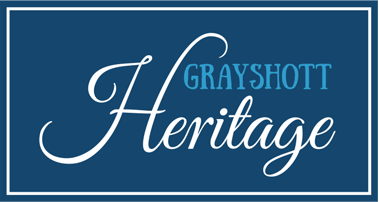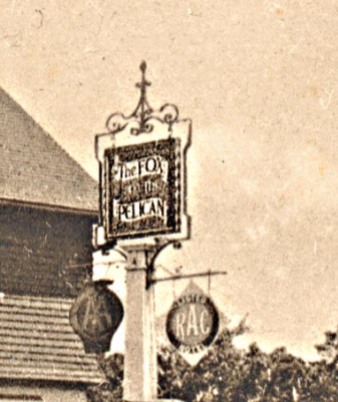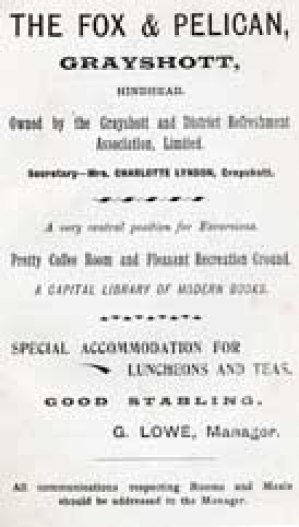An Investigation into the Fate of the Original Outdoor Sign at the Fox & Pelican Public House, Grayshott
Brian Tapp and David Barrett
Summary
The Grayshott Refreshment Association opened the Fox & Pelican public house in Grayshott in 1899. The pub’s sign was designed and painted by Walter Crane R.W.S., R.I. but it became damaged by the weather and was replaced with a copy. The original was given to the Grayshott Parish Council in January 1914 for safe keeping who duly passed it on to the Village Hall. Minutes of the Hall’s Management Committee in 1914 show that the Chairman, Dr. Arnold Lyndon (an art lover) agreed to have the painting restored but thereafter, though Dr. Lyndon remained Chairman of the Committee until his death in 1947 there is no further reference to the painting or its whereabouts. The painting is not to be found in the present Management Committee’s inventory of assets.
So, ‘What happened to Crane’s Fox and Pelican painting? Was it destroyed in the turmoil of the 1st World War or simply lost during that period? If simply lost, where is the painting now? It was not in included in the items publicly sold following the deaths of Dr. Lyndon and his wife. The Royal Academy of Arts has been unable to shed any light on this issue and an article in the Antiques Trade Gazette by Richard Peskett did not yield any useful response. Hopefully someone will come forward with answers to these questions.
Should you have any information on the whereabouts of Crane’s original Fox & Pelican public house sign please send it to the Secretary of the Grayshott Heritage, David W A Barrett, 20 Rozeldene, Hindhead, Surrey GU26 6TW or by the Grayshott Heritage web site contact page.
In his book, ‘Grayshott’1 J M Smith (1978) records that Sir Frederick Pollock as Chairman of the Grayshott and District Refreshment Association noted in an earlier book, For My Grandson ‘that the Association had some difficulty in choosing a name for its new Refreshment House. However, it decided upon ‘The Fox and Pelican’. Walter Crane painted us a mighty pretty signboard (long since taken indoors to be preserved as a memorial and replaced by a copy)’.
Smith went on to say that ‘Mrs. Winkworth gave the signboard, designed and painted by Walter Crane R.A.2 and the following description of it was printed in the Herald on 7th April 1900. ‘Upon the background which is red upon the upper and green upon the lower portion, there is painted a white pelican with outstretched wings guarding a nest where there are three of its young [from a fox]. The pelican is pecking her own breast, upon which blood is to be seen, the artist having followed the old fable that the pelican was accustomed to feed its young from its own breast. The reverse of the sign board has a red back ground upon which is painted an oak branch with leaves and fruit and a blue and white scroll with name of the inn.’
1Petersfield Bookshop (1978)
2Miss Elizabeth King, a Research Assistant at the Royal Academy wrote to Village Archive on the 26th February 2009 saying, ‘Walter Crane was not, in fact a member of the Royal Academy although he did exhibit here twice in the nineteenth century. He was a member of both the Royal Water-colour Society (RWS) and the Royal Institute of Water-colour Painters (RI) whose interests are, today served by the Federation of British Artists’.
On November 5th 2008, David Barrett, Secretary of the Grayshott Village Archive received the following email from his colleague Brian Tapp.
I’ve been to the Parish Offices today researching the Clinic etc.> > However, on going through the Minute Books I found an entry dated 20th January 1914 re the F & P sign. This basically stated that the PC had received an approach from the Grayshott Refreshment Assoc. whereby they offered the sign to the PC, following the transfer of the F & P to the London Society, as they considered the sign should become parish property. It was recorded that the gift was accepted and that it should be put up in the Village Hall premises in a position selected by the Management Committee.
As Treasurer of the Grayshott Village Hall in the 1990s David Barrett had organised more than one inventory of Hall property and none of these inventories recorded a Crane painting.
After contacting Peter Budd, the Minute Secretary at the Grayshott Village Hall, David Barrett was given access to the Hall Management Committee’s minute book covering the period August 20th 1907 to May 19th 1925. Peter pointed him in the direction of two items in 1914, on (i) pages 95, 97 & 99 and (ii) pages 100 & 101 of the minute book relevant to our investigation.
Item i : pages 95, 97 & 99 from the Grayshott Village Hall minute book 1914
‘A Meeting of the Management Committee of the Grayshott & Hindhead Institute & Village Hall was held in the Technical room at 8.30pm on Tuesday Jan 20th 1914, Dr. Lyndon in the Chair.
Fox & Pelican Signboard
Dr. Lyndon stated that the original Signboard of the Fox & Pelican, painted by Walter Crane, had been presented to the Parish Council and was to be deposited in the Village Hall. Mr. Cornish proposed, J W Petter seconded & it was carried that the Chairman, Mrs. Lyndon and the Hon. Sec. be appointed a Sub-Committee to select a suitable place to hang it.’
Signed ‘Arnold Lyndon Ap 21 1914’
Item ii : pages 100 & 101
Fox & Pelican Signboard
‘A Meeting of the Management Committee of the Grayshott & Hindhead Institute & Village Hall was held in the Technical room at 8.30pm on Tuesday April 21st 1914, Dr. Lyndon in the Chair.
In the minutes of this meeting ‘it was mentioned that the Fox & Pelican signboard was in a very bad state & as the original varnish was sticky it would become worse & worse if hung in the Hall in its present condition & also that Dr. Lyndon had kindly promised to have it cleaned and re-varnished’.
A careful search to the end of the minute book (ending August 14th 1925 when Dr. Lyndon was still Chairman of the Management Committee) by both David Barrett and Brian Tapp discovered no further reference to the Fox & Pelican signboard.
This is very puzzling but we should remember that the whole country was entering very turbulent and difficult times.
Indeed at the very next meeting of the Committee (October 29th 1914) under the heading ‘Billeting at the Village Hall’ the Hon. Secretary recorded
‘This subject was discussed at considerable length & it was decided that the Hon. Sec. Should endeavour to make the best terms he could with the War Office & if necessary call another Meeting. The Hon. Sec. stated that the arrangements he had made in view of the Hall being taken, with Mrs. Bulley & Miss Moir; & what he proposed to do with the goods belonging to the Hall. Mr. Mitchell undertook to see about getting the billiard table taken to pieces & stored.’
Inventories were taken of Hall property in 1922 and 1923 and on each occasion were declared to be ‘satisfactory’.
Our subsequent search of the Village Hall’s Management Committee minute book extending from August 14th 1925 to April 29th 1947 (when Dr. Lyndon died) did not reveal any reference whatsoever to the fate of the Fox and Pelican Sign.
Conclusions
Dr. Lyndon removed the signboard from the Hall for renovation during or before April 1914. During July 1914 it became apparent that the War Office would requisition the Village Hall, and all valuable Hall property had to be removed e.g. the billiard table, and placed in store. In these circumstances the signboard would certainly not have been returned to the Hall by Dr. Lyndon, renovated or otherwise.
The signboard remained with Dr. Lyndon for the rest of the World War I or had been sent by him to a third party for renovation and restoration. If so, why did Dr. Lyndon fail to report the whereabouts or condition of the signboard to the Village Hall’s Management Committee after the war. Was it simply stored away and forgotten? This seems unlikely, as Dr. Lyndon appears to have been a lover of art. Richard Peskett, a well-known authority on Grayshott Village history tells us that the painting was certainly not listed in the sale of Dr. Lyndon’s effects after his death. Dr. Lyndon’s wife pre-deceased him.
So, following our investigations we are no nearer in answering the questions, ‘What happened to Crane’s Fox and Pelican painting? Was it destroyed in the turmoil of the 1st World War or simply lost during that period? If simply lost, where is the painting now? Who has possession of the painting: certainly not the present Management of the Grayshott Village Hall?’ The Royal Academy of Arts has been unable to shed any light on this issue and an article in the Antiques Trade Gazette by Richard Peskett did not yield any useful response. Hopefully someone will come forward with answers to these questions in due course.
Brian Tapp and David Barrett
Grayshott Village Archive
April 2009
Correspondence to the Grayshott Village Archive should be addressed to the Secretary:
David W A Barrett
20 Rozeldene
Hindhead
Surrey
GU26 6TW
or by the Grayshott Heritage web site contact page.
Fox and Pelican History
Origins & Early History
The establishment of a public house in Grayshott originally arose following the purchase of land in the village by Alton Brewery. In 1893, land which had formerly been allotments, was purchased by John Ward, an Estate Agent who sold it on in 1898 to Gerald Hall, a family member of the Alton Brewery Company, at a price of £750.00.
(This land was eventually sold back to the Ward family and later purchased by Dr. Arnold Lyndon and Thomas Crook in 1913 who later conveyed it to Grayshott Parish Council in 1914 for the purposes of use as a Village Green, now known as Lyndon Green.)
Peoples Refreshment House
In 1898 a number of leading Grayshott residents, including the Rev. Jeakes, later to be appointed Vicar of Grayshott, Mrs. Charlotte Lyndon and Sir Frederick Pollock, were concerned that a commercially run Public House was about to be established by Alton Brewery on land now known as Lyndon Green. A scheme was put forward to establish a privately run refreshment house, which would sell alcoholic and non-alcoholic beverages under the guidelines of the national Peoples Refreshment House Association similar to those adopted in other parts of the country. The Association was a temperance-based association, based on principles which originated in Sweden.’
Grayshott & District Refreshment Association
The result was the formation of the Grayshott & District Refreshment Association, organised and run by a Village Trust, which was established with the issue of shares to the public in order to raise an estimated sum in excess of £2,000. Land was acquired and local builders Chapman & Puttick quoted a figure of £1465 for the building excluding the fitting out cost. A total of 68 shareholders took up the offer, with shares being acquired by the above dignitaries, together with owners of local businesses, local workers and also George Bernard Shaw. The profits from the house, after providing a moderate interest to the shareholders, were to be devoted to improvements of the village.
An application was made for a trading license, which happened to be heard at the same sitting as an application by the Alton Brewery for a public house to be built on the Lyndon Green land. The Brewery application was refused and a license granted to the Grayshott & District Refreshment Association in January 1899
The name of the Refreshment House was to be the Fox & Pelican, suggested by the Chairman of the Association Sir Frederick Pollock, who had links with Corpus Christi College, Cambridge. This name arose from the fact that the House was to be in the diocese of Winchester, and the sixteenth century Bishop, Bishop Fox, was also the founder of Corpus Christi College. “Fox” was therefore taken from the Bishops name, and “Pelican” from the Bishops device (coat of arms) – a Pelican, which is also the crest of Corpus Christi College.
The Sign Board
The signboard of the new establishment was donated by Mrs. Winkworth and had been designed and painted by Sir Walter Crane, R.A., head of the Royal College of Art from 1898 to1899. The sign depicted a white pelican with outstretched wins protecting her young above a fox on one side and a scroll and the name of the house on the reverse. The following photographs are of the original sign taken in c.1902. The original sign was soon taken down for preservation purposes and replaced with a copy, no record has been found to indicate its current whereabouts.
The House or Inn
The House or Inn, was formerly opened on 23rd August 1899 by Mrs. Randall Davidson, wife of the then Bishop of Winchester Dr. Davidson, who was later to become Archbishop of Canterbury. The opening was widely reported in the National press including the London Morning Star, The Daily Telegraph and the London Star.
The inn had four bedrooms available for let at a cost of two shillings and sixpence (12 ½ new pence) for a single room per night, with breakfast at one shilling and dinner two shillings, later, in1900 a further two bedrooms were added. The inn also had a coffee shop, a stable, a bicycle shed and a library, which included books donated by George Bernard Shaw. Books included works by Kipling, Tolstoy, DuMaurier, and perhaps to the point “Temperance Problems & Social Reform” by Rowntree & Sherwell.
It is worth noting perhaps, that electricity was not introduced to the village until 1901, with street lighting being introduced in 1914,mains water in 1904 and gas in 1909. The population of Grayshott according to the 1901 census was 666.
The basis of the business operation of the inn under the guidelines of the Refreshment House Association, was that it should be commercially sound whilst at the same time, combating against a commercially run inn such as may be run by a Brewery with all the social implications that such might entail. This meant, in effect, selling as little alcohol as possible with the emphasis being on non-alcoholic beverages. Under temperance principles, alcohol was purchased by the inn at retail price, with therefore no profit available on which the manager could earn commission. The main profit was earned on the non-alcoholic beverages, food and accommodation. The manager was instructed to keep the alcohol out of sight and to sell it only when specifically requested by customers. (The price of a pint of beer at this time was three pence a pint, lunches in the tap room were six pence).
The Haslemere & Hindhead Guide published in 1901 describes the inn as follows:
“The village is also noted for its “reformed” public house, the Fox and Pelican, easily recognisable by the artistic sign which Mr. Walter Crane painted as token of his sympathy with this praiseworthy endeavour to cope with the temperance problem on really practical lines. Externally the “house” is attractive; internally, its arrangements and appointments have deservedly won for it hearty approval of all classes of visitors. According to the principles by which the inn is conducted intoxicating liquor is on sale-but under conditions which deprive the vendor of any motive for unduly pressing its sale, and which give the consumer every facility for spending his money and his time rationally. Simultaneously, the total abstainer who seeks refreshment will find that his taste and needs are admirably and sympathetically catered for.”
The First Manager
The first manager appointed was a Mr. Wallace, a former naval steward described “as a substantially built and alert businesslike man”, and he was paid a salary plus a commission. Soon after opening, Mr. Wallace left to be replaced by a Mr. Wilshire. The short term history of managers was not good, six managers being appointed between 1899 and 1904. Initially, the basis on which the inn was operated was very successful but soon became more difficult, due in part with the numerous changes in managers and objections to the temperance practices by locals. In September 1899, local magistrates fined the manager 10 shillings for allowing a man to get drunk and to remain on the premises. A local paper also reported;-
” A very short time proved that the working of the house was not to be at all easy. The very laws framed to prevent drunkenness or anything approaching it proved a stumbling block, as to reconcile them with the intricate requirements of the licensing laws needed very keen management”.
In 1903, the Peoples Refreshment House Association made an offer to purchase the Grayshott & District R.H.A. but this offer was rejected following a Special General Meeting. The inn continued under the then present ownership until 1913 when it was transferred to the national Association, who held it until the late 1950’s when it was taken over by Gales Brewery.
Very few records exist of events once the inn was completely established and accepted by the community. However it is known that the first annual dinner of the village Cricket Club was held there in 1900, and that a supper was held for pensioners in the inn to celebrate King George V and Queen Mary’s jubilee in 1935.
Brian Tapp
Grayshott Village Archive, August 2007
Photographs: Richard Peskett
Acknowledgments
‘Grayshott-Story of a Hampshire village’ by J.H. Smith 1978, reprinted John Owen Smith 2002
Haslemere & Hindhead Guide 1901
Reference: Grayshott Village Archive 040 04









